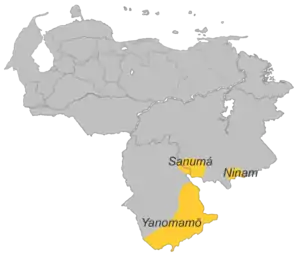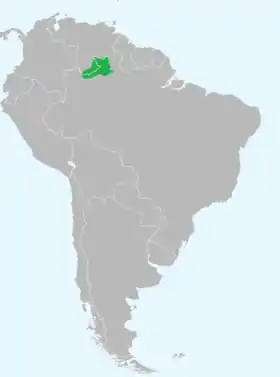Yanomaman languages
Yanomaman (also Yanomam, Yanomáman, Yamomámi, Yanomamana, Shamatari, Shirianan) is a language spoken by about 20,000 Yanomami people in southern Venezuela and northwestern Brazil (Roraima, Amazonas).
| Yanomaman | |
|---|---|
| Ethnicity | Yąnomamö |
| Geographic distribution | Amazon |
| Linguistic classification | One of the world's primary language families |
| Glottolog | yano1260 |
 Yanomaman languages in Venezuela | |
Subdivision

Ferreira et al. (2019)
Ferreira, Machado & Senra (2019) divide the Yanomaman family into two branches, with six languages in total.[1][2]
- Ninam-Yanomam-Yaroamë
- Nimam
- Ninam (also known as Yanami, Yanami-Ninami) - 900 speakers in Venezuela and Brazil
- Yanomam-Yaroamë
- Nimam
- Sanumá
- Sanumá (also known as Tsanuma, Sanima) - 5,100 speakers mainly in Venezuela
Sanumá is the most lexically distinct. Yanomamö has the most speakers (20,000), while Yãnoma has the fewest (178).
Genetic relations
Yanomaman is usually not connected with any other language family. Joseph Greenberg has suggested a relationship between Yanomaman and Macro-Chibchan. Migliazza (1985) has suggested a connection with Panoan and Chibchan. Neither proposal is widely accepted.[4]
Language contact
Jolkesky (2016) notes that there are lexical similarities with the Irantxe, Taruma, Katukina-Katawixi, Puinave-Kak, Tupi, Arawa, Guahibo, and Jivaro language families due to contact.[3]
Name
Yanomami is not what the Yanomami call themselves (an autonym), but rather it is a word in their language meaning "man" or "human being". The American anthropologist Napoleon Chagnon adopted this term to use as an exonym to refer to the culture and, by extension, the people. The word is correctly pronounced thorough nasalisation. As the phonetic sound 'ö' does not occur in English, variations in spelling and pronunciation of the name have developed, with Yanomami, Yanomamö, Ya̧nomamö, and Yanomama all being used. Some anthropologists had published the spelling Yanomamɨ to indicate the correct vowel [ɨ], but because many presses and typesetters eliminate the diacritical marks, an incorrect pronunciation of the name has emerged.
Characteristics
Phonology
Yanomaman languages have a phonological distinction between oral and nasal vowels. There are seven basic vowel qualities: /a e i o u ɨ ə/, which can occur as oral or nasal sounds.[5]
| Front | Central | Back | ||||
|---|---|---|---|---|---|---|
| Oral | Nasal | Oral | Nasal | Oral | Nasal | |
| Close | /i/ | /ĩ/ | /ɨ/ ‹y› or ⟨ö⟩ | /ɨ̃/
‹ỹ› |
/u/ | /ũ/ |
| Mid | /e/ | /ẽ/ | /ə/
⟨ë⟩ |
/o/ | /õ/ | |
| Open | /a/ | /ã/ | ||||
In the table above, the practical orthography is shown in angle brackets below the phoneme, if different.
The Yanomaman languages present extensive nasal harmony. When in Yanomaman words, a vowel is phonetically nasalized, all vowels that follow within the same word are also nasalized. The consonants of Yanomama are shown in the table below:[5]
| Labial | Alveolar | Postalveolar | Palatal | Velar | Glottal | |
|---|---|---|---|---|---|---|
| Stop | p | t tʰ | k | ʔ | ||
| Nasal | m | n | ||||
| Fricative | s | ʃ | j | h | ||
| Approximant | w | l |
Syntax
Yanomaman languages are SOV, suffixing, predominantly head-marking with elements of dependent-marking. Its typology is highly polysynthetic. Adjectival concepts are expressed by means of stative verbs, there are no true adjectives. Adjectival stative verbs follow their noun.
There are five demonstratives which have to be chosen according to distance from speaker and hearer and also according to visibility, a feature shared by many native Brazilian languages such as Tupian ones including Old Tupi. Demonstratives, numerals, classifiers and quantifiers precede the head noun.
There is a distinction between alienable and inalienable possession, again a common areal feature, and a rich system of verbal classifiers, almost a hundred, they are obligatory and appear just before the verb root. The distinction between inclusive and exclusive 1st person plural, a feature shared by most Native American languages, has been lost in Yanam and Yanomam dialects, but retained in the others.
Yanomami morphosyntactic alignment is ergative–absolutive, which means that the subject of an intransitive verb is marked the same way as the object of a transitive verb, while the subject of transitive verb is marked differently. The ergative case marker is -ny. The verb agrees with both subject and object.
Evidentiality on Yanomami dialect is marked on the verb and has four levels: eyewitness, deduced, reported, and assumed. Other dialects have fewer levels.
The object of the verb can be incorporated into it, especially if it not in focus:
Non-incorporated:
- kamijə-ny sipara ja-puhi-i
- 1sg-ERG axe 1sg-want-DYNAMIC
- 'I want an/the axe'
Incorporated:
- kamijə-ny ja-sipara-puhi-i
- 1sg-ERG 1sg-axe-want-DYN
- 'I want [it], the axe'
Relative clauses are formed by adding a relativizing ('REL' below) suffix to the verb:
- wãro-n shama shyra-wei ware-ma
- man-ERG tapir kill-REL eat-COMPL
- 'the man who killed the tapir ate it'
Sanuma dialect also has a relative pronoun ĩ.
Vocabulary
Loukotka (1968) lists the following basic vocabulary items for Yanomaman language varieties.[6]
| gloss | Shirianá | Parimiteri | Sanemá | Pubmatari | Waica | Karime | Paucosa | Surára |
|---|---|---|---|---|---|---|---|---|
| one | kauitxamhét | chaamí | muliman | mahón | ||||
| two | tasíma | polakabí | botokaki | porakabö | ||||
| three | tasimaimhét | hiːriːpólagʔa | prukatabö | |||||
| head | bel-éhe | pil-héawan | pi-hé | pei-hé | pei-yáhe | ne-umgipe | peːiua-hé | |
| ear | beli-yaméke | pilmórokwiːn | pi-xinkawán | yímikek | pei-yameke | peːiua-niumekakeː | ||
| tooth | beli-uáke | pil-nákwan | pi-nakuán | pei-uák | pei-uáke | ne-parike | peːiua-uáke | |
| man | horóme | waro | wandzyé | wanodá | ũálõ | uáru | uau | uhanó |
| water | mãepe | madzyu | maduú | mãõ | mahu | maú | maú | |
| fire | oáke | kwárogʔe | kuadák | koawáke | oáke | uauká | kauːwaká | |
| stone | mamáke | muadamiːn | máma | mama | ||||
| sun | belipshí | pilmórokwiːn | pilmoró | motóka | motúka | mitukaki | peniboːínshi | |
| manioc | nazygóke | naasʔís | nashita | makóke | ||||
| jaguar | déhe | póleawan | poʔlé | íla | téhe | ührá |
References
- Hammarström, Harald; Forkel, Robert; Haspelmath, Martin, eds. (2017). "Yanomaman languages". Glottolog 3.0. Jena, Germany: Max Planck Institute for the Science of Human History.
- Ferreira, Helder Perri; Machado, Ana Maria Antunes; Senra, Estevão Benfica. 2019. As línguas Yanomami no Brasil: diversidade e vitalidade. São Paulo: Instituto Socioambiental (ISA) and Instituto do Patrimônio Histórico e Artístico Nacional (IPHAN). 216pp. ISBN 978-85-8226-076-0
- Jolkesky, Marcelo Pinho de Valhery. 2016. Estudo arqueo-ecolinguístico das terras tropicais sul-americanas. Ph.D. dissertation, University of Brasília.
- Campbell, Lyle (2012). "Classification of the indigenous languages of South America". In Grondona, Verónica; Campbell, Lyle (eds.). The Indigenous Languages of South America. The World of Linguistics. 2. Berlin: De Gruyter Mouton. pp. 59–166. ISBN 978-3-11-025513-3.
- Ferreira, Helder Perri (2017). Yanomama Clause Structure. Utrecht: LOT.
- Loukotka, Čestmír (1968). Classification of South American Indian languages. Los Angeles: UCLA Latin American Center.
Bibliography
- Aikhenvald, Alexandra Y. & Dixon R.M.W. (1999) The Amazonian Languages Cambridge Language Surveys (p. 341-351)
- Campbell, Lyle. (1997). American Indian languages: The historical linguistics of Native America. New York: Oxford University Press. ISBN 0-19-509427-1.
- Greenberg, Joseph H. (1960). General classification of Central and South American languages. In A. Wallace (Ed.), Men and cultures: Fifth international congress of anthropological and ethnological sciences (1956) (pp. 791–794). Philadelphia: University of Pennsylvania Press.
- Greenberg, Joseph H. (1987). Language in the Americas. Stanford: Stanford University Press.
- Kaufman, Terrence. (1990). Language history in South America: What we know and how to know more. In D. L. Payne (Ed.), Amazonian linguistics: Studies in lowland South American languages (pp. 13–67). Austin: University of Texas Press. ISBN 0-292-70414-3.
- Kaufman, Terrence. (1994). The native languages of South America. In C. Mosley & R. E. Asher (Eds.), Atlas of the world's languages (pp. 46–76). London: Routledge.
- Mattei-Müller, M. (2007). Lengua y cultura yanomami: diccionario ilustrado yanomami-español, español-yanomami. Caracas: CONAC.
- Migliazza, E. C. (1972). Yanomama grammar and intelligibility. Indiana University. (Doctoral dissertation).
- Migliazza, Ernest C. (1985). Languages of the Orinoco-Amazon region: Current status. In H. E. Manelis Klein & L. R. Stark (Eds.), South American Indian languages: Retrospect and prospect (pp. 17–139). Austin: University of Texas Press.
- Migliazza, Ernest C.; & Campbell, Lyle. (1988). Panorama general de las lenguas indígenas en América. Historia general de América (Vol. 10). Caracas: Instituto Panamericano de Geografía e Historia.
Dictionaries
- Müller, Marie-Claude Mattei. (2007) Diccionario ilustrado yanomami-español / español-yanomami. Caracas: Epsilon Libros. 782pp.
External links
- Grupo yanomáman (in Spanish). PROEL – Promotora Española de Lingüística.
- ELAR archive of Documentation and Description of the Yanomama of Papiu
- The Yanomami Language
- Yanomámi (Intercontinental Dictionary Series)